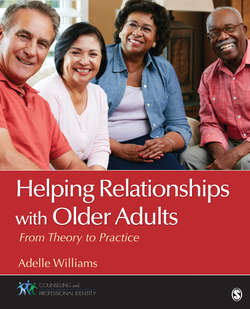Читать книгу Helping Relationships With Older Adults - Adelle M. Williams - Страница 40
На сайте Литреса книга снята с продажи.
Cognitive Changes That Accompany Aging
ОглавлениеIn general, cognitive changes are much more subtle than physical changes. Cognitive abilities peak in young adulthood (Ericsson, 2000). Losses in midlife occur primarily during peak performances; in other words, declines in developmental reserve capacity are apparent when performance is pushed to its limits (Lindenberger, Marsiske, & Baltes, 2000). Differences in cognitive developmental change can be seen when distinguishing between fluid and crystallized intelligence. Crystallized intelligence refers to general knowledge developed through a lifetime of experiences (accumulated knowledge) (Sternberg, Grigorenko, & Oh, 2001). In contrast, fluid intelligence refers to the “creative and flexible thinking” required to solve novel problems (e.g., anagrams, memory tests).
Generally, fluid intelligence declines with age, but crystallized intelligence remains stable or even increases (such as when one becomes specialized in a career, hobby, etc.) across the life span. It is important to distinguish between fluid intelligence pertaining to the solving of more practical problems versus more traditional (academic) problem-solving tasks. Performance on traditional problem-solving tasks peaks around the age of 20 and then declines, whereas performance on practical problem-solving tasks peaks in midlife, suggesting that it is at this time that individuals are best at practical problem solving (Sternberg et al., 2001).
Fluid cognition or fluid reasoning, the capacity to think logically and solve problems in novel situations, independent of acquired knowledge, has been shown to decline from midlife onward as a result of normal aging (Richards, Shipley, & Fuhrer, 2004; Singh-Manoux, Kivimaki, & Glymour, 2012), while cognitive decline of functional or clinical significances is generally not detected until much later in life, often as a result of significant neurologic morbidity such as cerebrovascular disease (Richards et al., 2004). Given that changes in cognitive and physical functioning probably result from interactions between aging and disease, their effects may not be fully distinguishable (Blumenthal, 2003). As people age, some individuals experience normal declines in physical and cognitive functioning that increase their risk of dependence on others and premature death (Cooper, Kuh, & Cooper, 2011; Cooper, Kuh, & Hardy, 2010; Dewey & Saz, 2001; Studenski, Perera, & Patel, 2011). There are, however, remarkable individual differences in rates of age-associated decline in the age at which these declines begin to accelerate.
In their related dual-processing model, Baltes and colleagues (1999) distinguish between the mechanics of intelligence that generally refer to processing abilities (information-processing strategies and problem-solving functions) independent of specific content and the pragmatics of intelligence that typically refer to knowledge about facts and procedures, including practical thinking, expertise, wisdom, and knowledge accumulated across the life span.
While the pragmatics of intelligence are expected to grow into adulthood and then remain stable into old age, there is abundant evidence of age-related decline in the mechanics of intelligence (Salthouse, 2003). This decline compromises individual capacities beginning in midlife only under conditions of multitasking and time pressure (Lindenberger et al., 2000). Thus, the implications of these declines for everyday functioning in midlife are constrained to time-sensitive multitasking in everyday behavior (e.g., talking on the phone while merging into freeway traffic) and select professions (e.g., air traffic controllers). Strategies that are part of the pragmatics of intelligence (e.g., sequence activities to avoid multitask overload) in midlife can compensate for the weaknesses in the mechanics of intelligence. Such strategies may become increasingly insufficient as cognitive decline progresses in advanced old age. Guided Practice Exercise 1.4 provides the opportunity to examine physiological changes and one’s personal adaptation to inevitable changes.
Guided Practice Exercise 1.4
Numerous physiological changes occur as people age. Identify two of the major systems that change as one ages and discuss ways to adjust to these changes. What modifications in your current behavior will enable you to adjust more positively to these natural and inevitable changes?
